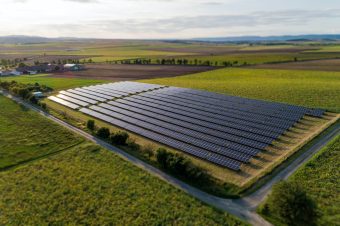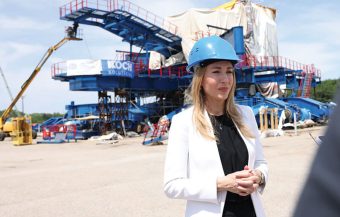The energy community recognized the Republic of Serbia as a leader in energy reforms in 2023 in the region. Key steps have been taken in improving the legislative framework and setting strategic goals for the future of the energy sector, which will contribute to the acceleration of the green transition, but also to raising the level of energy security. We spoke with Dubravka Đedović Handanović, Minister of Mining and Energy, about the energy transition, investments in renewable energy sources (RES), improvement of energy efficiency and support for energy-dangerous households.
How is Serbia’s energy transition going? You continue with the reform of the energy sector, what are the next steps?
– I believe that it will be best to present the progress of Serbia in the green energy transition in the previous two years through numbers. The number of prosumers increased from 400 to 3,200, the capacities of wind farms will be increased by nearly 40 percent by the end of the year, and for the first time we have exceeded 100 MW of solar capacity. We have a three-year auction plan for the allocation of market premiums, which foresees 1,300 MW, and already in the first one we achieved a result of 715 MW of wind farms and solar power plants (of which 425 are in the incentive system).

)
Every day we work diligently to reduce consumption in the household sector, so for the year around 10,000 households received state grants for improving energy efficiency in their homes. Looking only at the results achieved through the Clean Energy program in the previous year, energy savings were achieved equal to the production of the heating plant in Nis, which is also among the largest in Serbia. Our ambition is to further improve the legislative framework, which, in addition to amending the Energy Act, also includes the adoption this year of already prepared strategic documents, such as the Integrated National Energy and Climate Plan and the Energy Development Strategy. The state plays an active role in the process of energy transition as the bearer of large investments. Key investments in the energy transition that we are realizing in cooperation with the Electric Power Company of Serbia include the construction of self-balancing solar power plants with a capacity of 1 GW, the Kostolac wind farm of 66 MW that will be online next year, as well as the new reversible hydropower plants Bistrica and Đerdap 3. We put them into operation at the end of April. flue gas desulfurization plant in TENT A, the largest environmental project implemented in thermal power plants in Europe at the moment.
We decided to conduct auctions and award market premiums as a key incentive instrument for private projects, which the EU also recognized as one of the key tools for increasing the share of renewable energy sources. According to our strategic documents, the projections are that we will consume more energy in the future and we need stable energy sources when energy from renewable sources, solar and wind is not available to us. Therefore, we seriously and thoroughly started to consider the use of nuclear energy, which is the only one that can provide base energy and respect for the concept of zero CO2 emissions. If we know that we now get more than 60 percent of our energy from coal, it is clear that we cannot replace that amount of energy overnight. On the other hand, there are many uncertainties regarding the basic capacities that meet the condition of carbon neutrality, and we are aware that projects involving gas are exposed to numerous risks, from geopolitical ones, to the willingness of international institutions to finance them, to a possible change in the treatment of this energy source in the EU taxonomy. That is why we started to consider the option of including Serbia in the circle of countries that use nuclear energy. The reform of the energy sector began with the transformation of Elektroprivreda Srbije, which is the largest company in our country and which supplies all citizens and the largest part of the economy with electricity. This process, which we started in the midst of the energy crisis, is very complex and brings with it a number of challenges, which I believe we have adequately solved so far. Our goal is to protect workers in the energy transition, especially miners, and to provide better conditions for employees.
IN FOCUS:
Last year we had the first auctions for the allocation of market premiums for renewable energy sources. How satisfied are you with these auctions and when will the second round be announced?
– Adopting a three-year auction plan for the period 2023-2025. In 2018, we will provide at least 1,300 MW of new capacities from RES through private investments, through auctions and up to a portion of market premiums. Last year, we conducted the first auctions for the allocation of market premiums, the result of which were nine new power plants, twice the price of electricity achieved than the market price at that time, a new 715 MW (of which 425 MW is in the incentive system) and more than a billion euros of private investments. in the development of wind farms and solar power plants. This is a clear indication that Serbia has created an excellent environment and regulatory framework for the development of RES. We expect about 115 MW from auctions already at the end of this year on the grid, from wind and solar. The second round of auctions for around 400 MW of new green energy will be announced at the end of this year, as soon as we assess that the market is ready and that there are mature projects that can compete competitively for incentives, which we analyze daily. Through auctions, we plan to encourage investors to keep the produced green energy in Serbia, for our citizens and the economy. We will pay special attention to encouraging the construction of solar power plants and we will work to achieve the best possible price through good competition.

This year, the program of energy rehabilitation of households continues. What is included in this program and what awaits us by the end of the year when it comes to this?
– Three and a half times more energy is consumed in Serbia compared to the European average, which is why we support citizens to improve energy efficiency in their households in order to achieve energy savings between 25 and 30 percent, increase housing comfort and reduce the emission of harmful gases. We recently concluded contracts with 137 local self-governments, including municipalities from Kosovo and Metohija, in which this year we provided about two billion dinars for subsidies that will be able to be used by about 12,000 households. Citizens will be able to apply for subsidies as early as June, as soon as the local self-government units announce tenders, which, depending on the package of measures, can go up to 65 percent of the total investment value for the replacement of carpentry, insulation, facades, roofs, inefficient boilers and installation of solar panels and collectors. All these measures actively involve citizens in the energy transition process. So far, about 30,000 households have received government subsidies, while by the end of 2027, we will rehabilitate more than 70,000 households across the country. In cooperation with the World Bank, we provided 50 million dollars for subsidies to citizens.
In the framework of the household energy renovation program, special attention is paid to socially vulnerable households. How is the implementation of this project progressing?
-For now, energy-dangerous customers can apply for subsidies in 44 local governments. They are significantly higher than the subsidies that can be received by other citizens, in the amount of up to 90 percent of the energy rehabilitation value. Energy-sensitive customers will, thanks to minimal investments, improve the comfort of their homes and significantly reduce their bills. Translated into money, if the household changes carpentry for which the amount of the subsidy is, for example, 100,000 dinars, then the household will invest 10,000 dinars. We are dedicated to providing support to the most vulnerable citizens, so this project is an excellent opportunity to remind all interested parties that they can apply to their local governments throughout the year to obtain this status.
The interview was conducted by: Milica Radičević
Source: energetskiportal.rs


